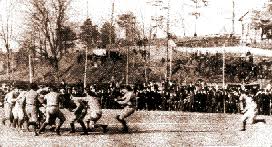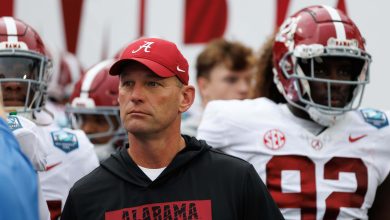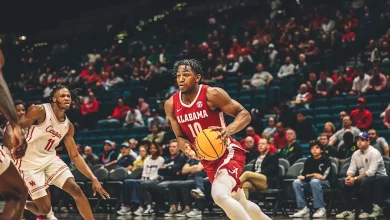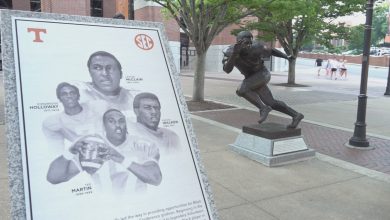1895 – The Iron Bowl is held in Tuscaloosa for the first time. Auburn, led by first-year head coach John Heisman, runs away with the victory, demolishing Alabama 48-0.

The year was 1895, and the burgeoning rivalry between two of Alabama’s fiercest football powers was about to take a monumental step forward. The Iron Bowl, the intense competition between Auburn University and the University of Alabama, had already begun to capture the imagination of college football fans throughout the South. But on this particular day in Tuscaloosa, the stakes, the spectacle, and the outcome would etch themselves permanently into the annals of college football history.
It was the first time the Iron Bowl was held on Alabama soil, a game that would not only stoke the fires of rivalry but also highlight the arrival of a coaching legend at Auburn—John Heisman. Heisman, in his inaugural year as Auburn’s head coach, brought with him fresh ideas, innovative strategies, and an uncompromising drive to build a winning program. What unfolded on that day was a stunning demonstration of dominance and skill, with Auburn running away with a 48-0 victory over Alabama in a game that sent shockwaves across the South.
To fully appreciate the significance of the 1895 Iron Bowl, it is essential to understand the context of the era. College football in the late 19th century was still in its infancy, evolving rapidly from a rough, often chaotic pastime into an organized, strategic sport. Teams were adopting new rules, formations, and plays, and rivalries like Auburn-Alabama helped propel the game into the cultural fabric of the region. Football was becoming a symbol of pride for schools, towns, and states, and victories on the gridiron translated into bragging rights that lasted for years.
The decision to hold the Iron Bowl in Tuscaloosa was strategic and symbolic. Until then, most games had been played on neutral fields or at Auburn’s home turf, but bringing the rivalry to Alabama’s home grounds was an effort to galvanize local support and deepen the intensity of the competition. Tuscaloosa was abuzz with anticipation, as students, alumni, and local fans packed the modest stadium and surrounding areas, eager to witness the showdown.
Auburn entered the game with a sense of purpose and determination. Under John Heisman’s leadership, the Tigers had undergone a transformation. Heisman was a forward-thinking coach known for his emphasis on speed, deception, and precision—qualities that set his teams apart. He believed in conditioning, disciplined practice, and tactical innovation at a time when many teams still relied on brute force and straightforward plays. His arrival at Auburn marked a new chapter, and the 1895 Iron Bowl was his first opportunity to make a statement against Alabama.
The Alabama Crimson Tide, on the other hand, were prepared to defend their home turf and uphold their growing reputation as a football power. Their squad was tough and competitive, with players eager to prove themselves against a revitalized Auburn team. The atmosphere was charged with tension and excitement as both sides took the field, knowing the significance of this historic matchup.
From the opening whistle, it became clear that Auburn was playing at a different level. Heisman’s Tigers executed with precision and speed, dazzling the crowd with a display of football that was both methodical and overwhelming. The offensive line created gaps with well-timed blocks, while the backs and ends exploited every opportunity to gain yardage. Auburn’s defense was equally impressive, shutting down Alabama’s attempts to mount any sustained drives.
The scoreboard began to reflect Auburn’s dominance quickly. The Tigers scored early and often, moving the ball with a fluidity that Alabama struggled to contain. Heisman’s innovative use of misdirection plays and strategic formations kept the Crimson Tide off balance, unable to anticipate or counter Auburn’s advances. Each touchdown was met with growing disbelief among Alabama fans, who had not seen such a lopsided performance in the rivalry’s brief history.
Auburn’s running game was particularly devastating. The backs, swift and agile, found openings and exploited them with relentless determination. The Tigers’ offensive unit moved like a well-oiled machine, executing Heisman’s plays with near-perfect timing. Meanwhile, Auburn’s defense was ferocious, forcing turnovers and halting Alabama’s offensive efforts at every turn.
As the game progressed, the score climbed to staggering heights. Auburn piled on points in every quarter, refusing to let up even with a commanding lead. The final tally of 48 points to Alabama’s zero was not only a decisive victory but also a declaration of Auburn’s ascendancy under Heisman’s coaching.
The crowd in Tuscaloosa was stunned. Alabama supporters, who had come hoping for a hard-fought contest, witnessed their team overwhelmed in a fashion that few had anticipated. The loss was a bitter pill to swallow, but it also ignited a fierce desire for redemption that would fuel the rivalry for decades to come.
For Auburn, the victory was a triumphant affirmation of Heisman’s vision and leadership. The coach’s methods had proven effective against one of their toughest rivals, and the players had embraced his demanding standards. The 1895 Iron Bowl became a defining moment for Auburn football, a game that marked the beginning of a new era of competitiveness and innovation.
John Heisman’s influence extended far beyond this single game. His contributions to football—both at Auburn and later at other programs—helped shape the modern game. The Heisman Trophy, named in his honor, stands today as one of the most prestigious awards in college sports, symbolizing excellence and achievement. But for Auburn fans in 1895, the memory of this crushing 48-0 victory over Alabama in Tuscaloosa was perhaps the most immediate and thrilling legacy of their legendary coach.
The game also had a lasting impact on the rivalry itself. The Iron Bowl grew in stature and intensity, fueled by moments like the 1895 contest. The passion, pride, and competitive spirit displayed by both teams contributed to making the Auburn-Alabama matchup one of the most storied and anticipated rivalries in college football history.
In the years following, both programs continued to evolve and compete at the highest levels. The lessons learned and the traditions established during games like the 1895 Iron Bowl helped forge the identities of both Auburn and Alabama football. The rivalry became a cultural phenomenon, drawing national attention and producing some of the sport’s most memorable moments.
Reflecting on the 1895 Iron Bowl, historians and fans alike recognize it as more than just a lopsided scoreline. It was a pivotal event that showcased the emergence of strategic coaching, the rise of southern football, and the power of collegiate athletics to inspire communities. The game was a testament to the dedication of players and coaches who pushed the boundaries of what was possible on the gridiron.
Today, as Auburn and Alabama face off year after year in packed stadiums and under bright lights, the echoes of that first Tuscaloosa Iron Bowl in 1895 remain. It serves as a reminder of the rivalry’s deep roots and the enduring passion that defines college football in the South.
The 48-0 victory by Auburn, led by first-year head coach John Heisman, stands as a landmark achievement in the history of the Iron Bowl. It symbolizes a turning point where innovation met tradition, where one team’s vision reshaped the landscape of southern football. For Auburn fans, it is a cherished memory of triumph; for Alabama, a challenge to overcome; and for college football as a whole, an early chapter in a story that continues to captivate and inspire.








